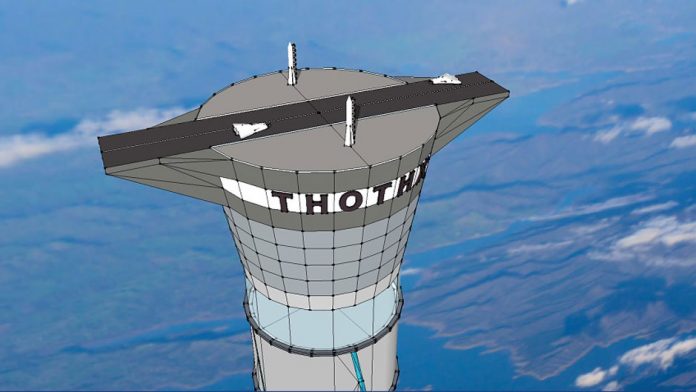Getting into space isn’t easy. Thinking of a typical rocket launch brngs up memories of spectacular flames and billowing clouds of smoke, blasting the rocket off the ground and into orbit. A single space shuttle uses over 700 metric tons of fuel during liftoff.
A typical rocket launch from the ground consumes over 700 metric tons of fuel during liftoff
Image: NASA
Ontario-based Thoth Technology, Inc. wants to change that by building an elevator that could bring objects 200 km into the sky, and into lower Earth orbit. The company recently received a US patent for its technology, based on stacked kevlar rings that would be inflated with either helium or hydrogen. Prof. Brendan Quine, Thoth Technology’s chief technical officer and assistant professor at York University, invented the patented technology and unveiled a seven-metre scale model back in 2009.
The initial plan now is to build a pilot tower 1.5 km tall in the next 5 years, easily eclipsing the 830-metre-tall Burj Khalifa in Dubai as the world’s tallest free standing structure. The next phase would see a tower standing 20 km tall in the next 10 years, which is about twice as high as the cruising altitude of most commercial airplanes. The platform at the top would eliminate the first stage of a conventional rocket launch, cutting fuel requirements by one third. This would still be only one tenth the final theoretical height that could be reached using this technology.
Critics might say that the proposed tower suffers from a few major flaws, the most pressing of which is that this is not a space elevator in the classical sense: a rocket would still be needed to reach space from its platform. A true space elevator would stretch thousands of kilometres above the Earth.
The traditional concept of a space elevator consists of a cable spanning the distance between a point on the equator and a counterweight in 36,000 km away, up in space beyond geostationary orbit. This set up would theoretically provide the necessary tension on the cable and maintain a stationary position. A design like this is not currently possible because the sheer weight of the cable itself demands a strong material, the likes of which we are currently unable to produce at the necessary lengths. A cable-based system would also need to be built in space, and damage from meteors and lightning strikes would require it to be replaced every six months.
Thoth Technology is hoping to get around some of these issues with a completely different concept. Instead of a cable-driven elevator, the idea is to first build a tower from the ground up, and then send up self-driven elevator cars: one idea is to design cars with claws and wheels that would follow spiral tracks up the tower. The inflatable structure would be pneumatically pressurized, allowing it to be controlled and tilted to resist external forces that might knock it down, such as hurricanes and other weather disruptions. This control would add stability for such a tall and slender tower.
A tower like this could also be useful for telecommunications and wind-based power generation. The tourism market for a 20 km tall tower also has strong potential; from the top, passengers would be able to see the bright blue rim of the Earth, and a panoramic view stretching 1,000 kilometres – which is about the distance from Vancouver to Saskatoon!









































